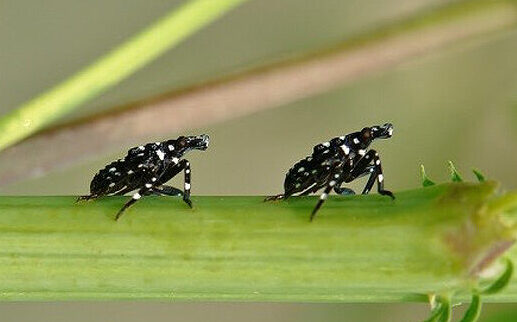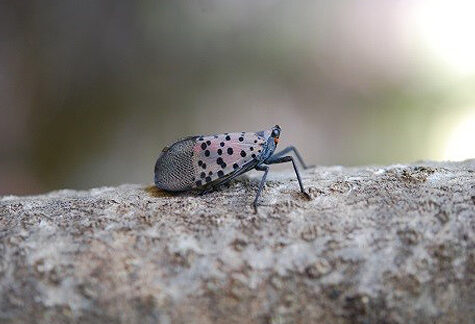MONDAY, JULY 10, 2023. BY USDA (APHIS).
The U.S. Department of Agriculture’s Animal and Plant Health Inspection Service (APHIS) Spotted Lanternfly Strategic Planning Working Group has released the Spotted Lanternfly (SLF) Five-Year Strategy for fiscal years 2024-2028. APHIS brought together the working group in August 2022 with representatives from APHIS, the National Association of State Departments of Agriculture (NASDA), and the National Plant Board (NPB). The working group developed a unified approach to reduce the spotted lanternfly’s spread and impacts through the effective use of available State and Federal resources.
“Spotted Lanternfly is an invasive pest that feeds on crops and natural resources. Over the next five years, Federal and State partners will work to limit the spotted lanternfly’s advancement as we further scientific research that will help us develop better pest management tools and options,” said USDA Marketing and Regulatory Programs Under Secretary Jenny Lester Moffitt.

On the left: Spotted lanternfly as an adult with wings open. Note the bright red coloration now visible on the hindwings. This cannot be seen when the insect is at rest. On the right: Spotted lanternfly egg mass. Credit: Pennsylvania Department of Agriculture
The five-year strategy prioritizes the following goals:
- Effectively limit the advancement of spotted lanternfly and efficiently respond to its introduction within Federal and State authority and resource availability.
- Support continued scientific research toward practical management and risk mitigation.
- Establish a consistent national and State-level outreach message and educational campaign for the public and industries at risk for spreading spotted lanternfly.
SLF has spread to 13 additional states since it was first detected in Pennsylvania in 2014. Spotted lanternflies prefer to feed on the invasive tree of heaven, but they also feed on a wide range of crops and plants, including grapes, apples, hops, walnuts, and hardwood trees. As resources available are limited, developing a strategy in coordination with the States to address this invasive pest is critical.

Spotted lanternfly first instar nymph (immature). Note that the nymph is black with white spots. This coloration persists through the third instar. Credit: itchydogimages
To reduce the spread, APHIS and states will create a framework to prevent human-assisted movement, promote public reporting and early detection, and continuously leverage the latest research and management tools available. The new strategy builds the capacity to combat SLF in areas at high risk of introduction and stresses that SLF management plans be based on the latest risk-assessment modeling data which helps predict where SLF populations may emerge. Federal and State partners will also unite their research resources and share knowledge about SLF to limit its movement and distribution. While leveraging best practices in the field, State and Federal partners will prioritize more research on climate and host-plant suitability, biocontrol agents, as well as other effective management tools.
In addition to representatives from APHIS, the Spotted Lanternfly Strategic Planning Working Group also included NASDA and NPB State representatives from California, Connecticut, Illinois, Indiana, New York, Oklahoma, Pennsylvania, South Carolina, Washington, and Virginia.
Steven Long, President of the National Plant Board and co-chair of the SLF working group said, “The National Plant Board believes that this renewed and refocused approach to managing spotted lanternfly will buy us the time needed to solve this plant pest riddle.”
Commissioner Bryan Hurlburt, Chair of the NASDA Plant Agriculture and Pesticide Regulation Committee and co-chair of the SLF working group shares, “On behalf of the National Association of State Departments of Agriculture, we are appreciative of our engagement with USDA and the National Plant Board to develop this comprehensive strategic plan. By sharing our unique experiences, we are able to continue our unified effort to combat the spread of spotted lanternfly with best-available tools and research.”
In May 2023, APHIS hosted a Tribal Listening Session on the Spotted Lanternfly Five-Year Strategy to provide Tribes insight on the plan and give them an opportunity to provide feedback. The webinar was well received with a few questions about funding, how to respond to the spotted lanternfly on sacred sites, and outreach support for Tribes. APHIS will continue to engage Tribes and solicit feedback on the spotted lanternfly management and outreach strategy.

Profile of spotted lanternfly adult at rest. Note the wings are held tent-like over the back of the insect. Credit: Pennsylvania Department of Agriculture
To learn more, visit usda.gov.
Have something interesting to say? Consider writing a guest blog article!
To subscribe to the Coffee Shop Blog, send an email to stephanie@lodiwine.com with the subject “blog subscribe.”
To join the Lodi Growers email list, send an email to stephanie@lodiwine.com with the subject “grower email subscribe.”
To receive Lodi Grower news and event promotions by mail, send your contact information to stephanie@lodiwine.com or call 209.367.4727.
For more information on the wines of Lodi, visit the Lodi Winegrape Commission’s consumer website, lodiwine.com.
For more information on the LODI RULES Sustainable Winegrowing Program, visit lodigrowers.com/standards or lodirules.org.


